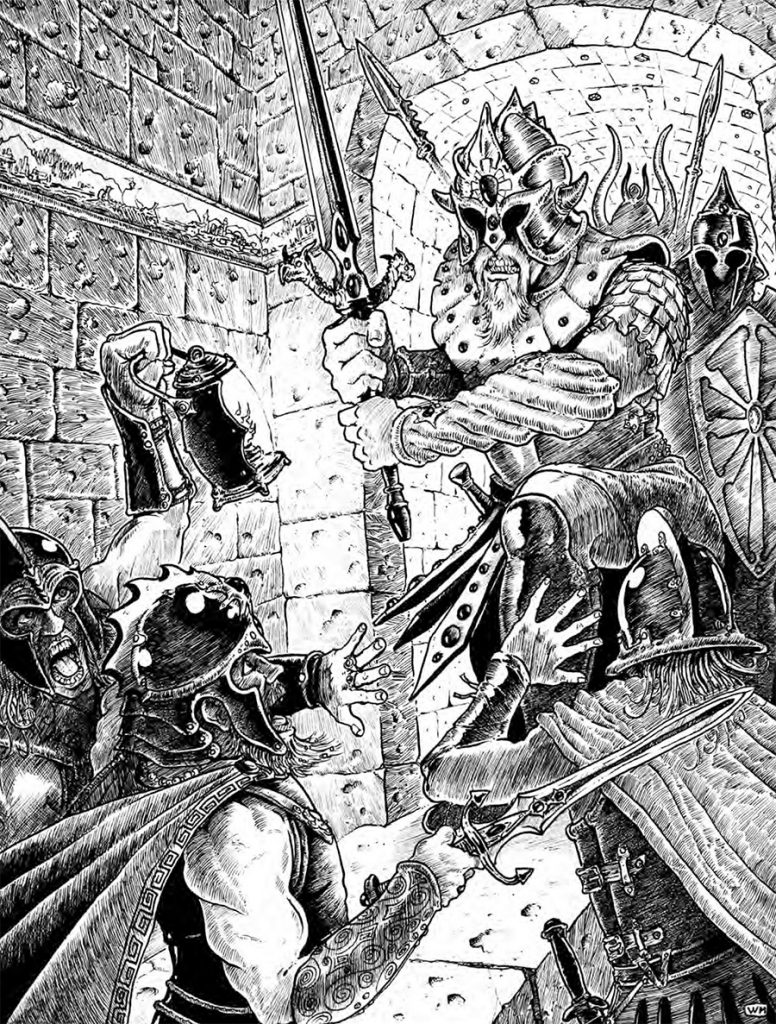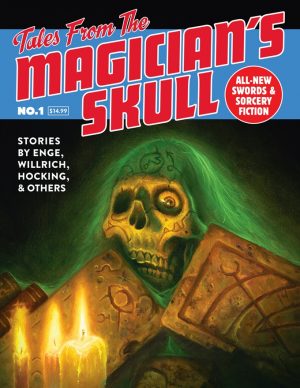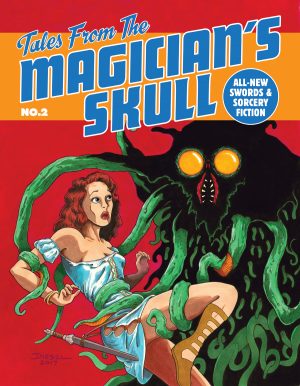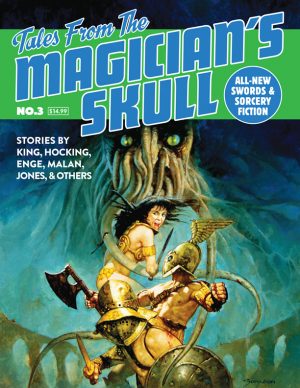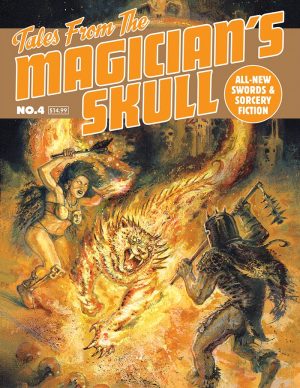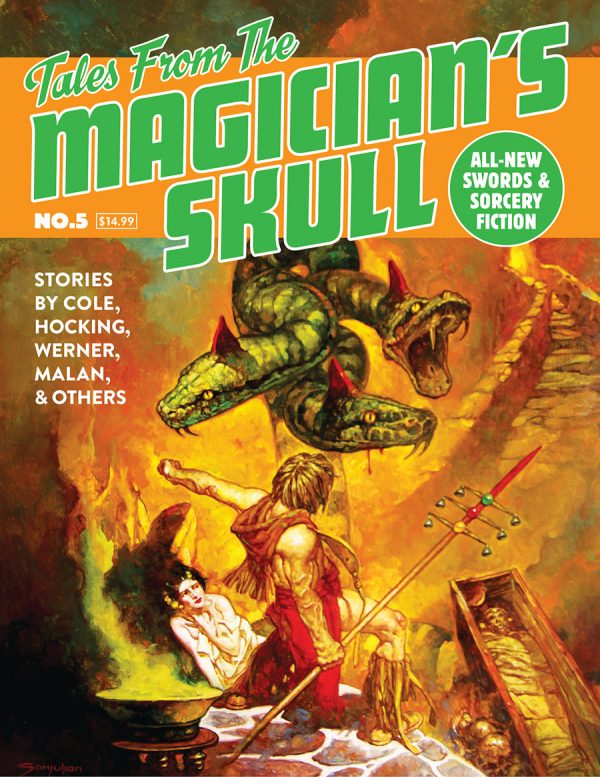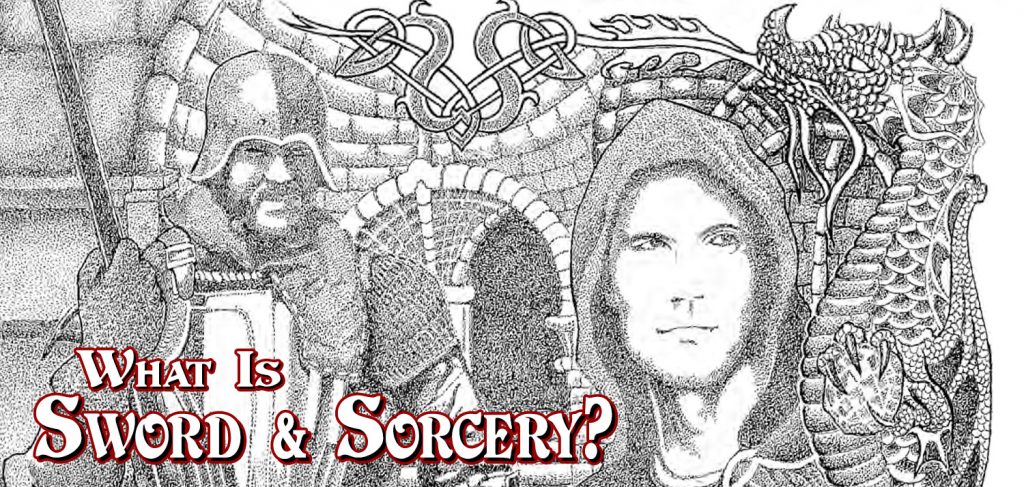
Defining Sword-and-Sorcery
by Howard Andrew Jones
At Bride of Cyclops Con—happening right now!—there is an entire track based around sword-and-sorcery. We encourage you to check out the entire schedule and be a part of the con. Before we get to that, though, Tales From The Magician’s Skull editor Howard Andrew Jones takes a minute to define exactly what sword-and-sorcery means…
The term “sword-and-sorcery” gets bandied around a lot. As far as we’re concerned here at The Skull, it’s not just a generic term that can be used interchangeably with fantasy fiction, but a descriptor of a specific sort of fantasy fiction, as intended by Fritz Leiber, the man who coined the phrase. I’ve been working on defining that definition over the years, with a little help from John Hocking, William King, Robert Rhodes, and John “The Gneech” Robey. I see sword-and-sorcery having at least these four characteristics:
- The Environment: Sword-and-sorcery fiction takes place in lands different from our own, where technology is relatively primitive, allowing the protagonists to overcome their martial obstacles face-to-face. Magic works, but seldom at the behest of the heroes. More often sorcery is just one more obstacle used against them and is usually wielded by villains or monsters. The landscape is exotic; either a different world, or far corners of our own.
- The Protagonists: The heroes live by their cunning or brawn, frequently both. They are usually strangers or outcasts, rebels imposing their own justice on the wilds or the strange and decadent civilizations which they encounter. They are usually commoners or barbarians; should they hail from the higher ranks of society then they are discredited, disinherited, or come from the lower ranks of nobility (the lowest of the high).
- Obstacles: Sword-and-sorcery’s protagonists must best fantastic dangers, monstrous horrors, and dark sorcery to earn riches, astonishing treasure, the love of dazzling romantic partners, or the right to live another day.
- Structure: Sword-and-sorcery is usually crafted with traditional structure. Stream-of-consciousness, slice-of-life, or any sort of experimental narrative effects, when they appear, are methods used to advance the plot, rather than ends in themselves. A tale of sword-and-sorcery has a beginning, middle, and end; a problem and solution; a climax and resolution. Most important of all, sword-and-sorcery moves at a headlong pace and overflows with action and thrilling adventure.
The protagonists in sword-and-sorcery fiction are most often thieves, mercenaries, or barbarians struggling not for worlds or kingdoms, but for their own gain or mere survival. They are rebels against authority, skeptical of civilization and its rulers and adherents. While the strengths and skills of sword-and-sorcery heroes are romanticized, their exploits take place on a very different stage from one where lovely princesses, dashing nobles, and prophesied saviors are cast as the leads. Sword-and-sorcery heroes face more immediate problems than those of questing kings. They are cousins of the lone gunslingers of American westerns and the wandering samurai of Japanese folklore, traveling through the wilderness to right wrongs or simply to earn food, shelter, and coin. Unknown or hazardous lands are an essential ingredient of the genre, and if its protagonists should chance upon inhabited lands, they are often strangers to either the culture or civilization itself.
Sword-and-sorcery distances itself further from high or epic fantasy by adopting a gritty, realistic tone that creates an intense, often grim, sense of realism seemingly at odds with a fantasy setting. This vein of hardboiled realism casts the genre’s fantastic elements in an entirely new light, while rendering characters and conflict in a much more immediate fashion. Sword-and-sorcery at times veers into dark, fatalistic territory reminiscent of the grimmer examples of noir-crime fiction. This takes the fantasy genre, the most popular examples of which might be characterized as bucolic fairy tales with pre-ordained happy endings, and transposes a bleak, essentially urban style upon it with often startling effect.
While sword-and-sorcery is a relative to high fantasy, it is a different animal. High fantasy, mostly invented by William Morris as an echo of Sir Thomas Mallory and then popularized by J.R.R. Tolkien, moves for the most part at a slow, stately, pace, meandering gently from plot point to plot point, or, as is often the case, from location to location.
While exotic landscape is present, even common, in sword-and-sorcery, it is displayed differently and toward a different effect. Sword-and-sorcery was birthed in an entirely different tradition. Robert E. Howard, its creator, wrote for the pulps. The pulp magazines, the television of their day, were fueled by quick moving action. The stories needed to grab you within the first few sentences so that if you were browsing the magazine at the news stand you’d feel compelled to purchase it to finish. The pulp stories were meant to seize your attention from the opening lines and never let go.
This difference in pacing is crucial and there are hidden difficulties attendant in trying to create it on the page. John Chris Hocking added this to the discussion: “Some sword-and-sorcery authors seem to believe that swift pacing must equal Action. And that Action must equal Violence. Neither of these things are true. All the fighting and running and frenzy you create will grow tiresome unless it is moving the story forward. Sure, Action is great unto itself, but it is the unfolding of the plot that truly captivates.”
Be sure to check out the gamut of Sword and Sorcery fiction in the pages of Tales From The Magician’s Skull!


